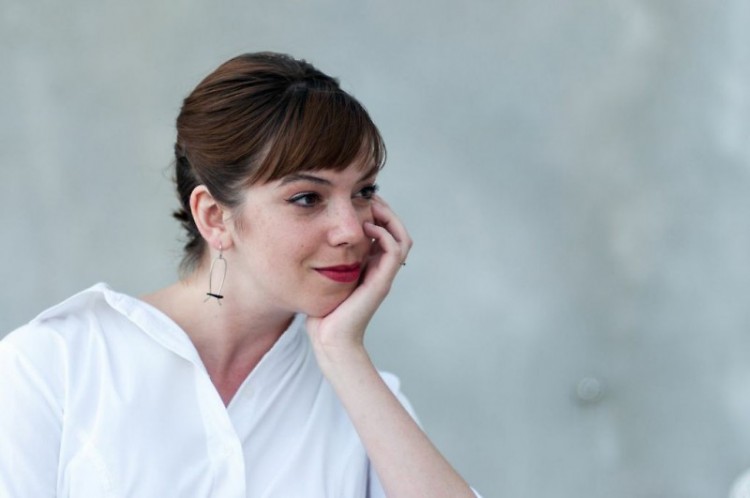"We're going to be the hub of creativity for the up and coming artists," asserts Miranda Krajniak, newly-appointed executive director of the Urban Institute for Contemporary Art (UICA) at the corner of Fulton and Division. "There's no such thing as competition in Grand Rapids. It's a value-add. And if everyone can really think that way, it would be so much better. There's always this paranoia that there's only so much out there. But no- there's plenty."
Krajniak, who has lived in downtown Grand Rapids since 2001, sees the art community and city as a whole as ready to take a leap.
"It's so exciting right now: it's like we're all standing on the cliff right now, and we're on the cusp, and it just needs to be a collective jump," she says. "Which is uncomfortable and often unpopular."
Krajniak describes the members of the art community not as competing entities but as members of an ecosystem, all dependent upon each other.
"All the arts organizations in Grand Rapids have to survive if we intend this to be an arts community" she says. "You can't let one go."
"We can't let the [Division Avenue Arts Collective] go. And the reason we can't let the DAAC go is because they serve a function that none of the rest of us serve. So in order for us to have a healthy ecosystem within the art community, the DAAC serves incredible purpose. We [UICA] serve a real purpose. And so does the GRAM and so does ArtPrize and so does SiTE:LAB. It's an ecosystem- everyone has to be there. The galleries have to be there. And if we all survive, then we can go to the next level as a community."
Krajniak joined the UICA just three months ago, accepting a role that put her in the middle of 3.9 million dollars of debt and with it the need for restructuring of staffing and programming.
"The UICA was not in a good place. It wasn't one person, or 12 people or 20 people- it was just decisions and choices that happened over a very expansive amount of time that lead to where we are now," she says. "My feelings aren't hurt that you tell me that we've done a terrible job or that we lost our mission."
Krajniak says they're winning back hearts and minds again, one by one, despite an extremely limited budget, by taking a grass-roots approach.
Not to mention a noticeably limited staff of 11.
"A lot of changes I didn't want to do, but I had to do. I was kind of forced by circumstances to make some changes. Survival is my number one goal, so it's been a difficult journey," she says. "So now we're actually starting the process of rebuilding."
That rebuilding includes the upcoming ArtPrize exhibit, of course, with more local artists than ever before.
"ArtPrize is not going to be stuffy," she says. "Our theme is play, so half of our art you have to play with in order for it to work. It should be a pretty joyful experience, which I'm excited about."
After ArtPrize, she's looking forward to exhibitions featuring Latin American artists and then "outsider art, treated very seriously." She hints at a full list of plans.
"I have a lot of things kind of on the stove, stirring the pot, but it's not quite ready yet," she says. "But we're ready to take the place as the jumping-off point for artists."
Frankly aware of the challenges set before her, Krajniak's infectious energy and perspective exhibit her belief in hard work and focus to revive the UICA into a once-again strong institution.
"I would say the first months were exceptionally difficult, but now it's getting to the point where it's almost fun. I can see the fun," she says. "Other people are having fun- and that really matters."
Her five years at the GRAM and more recent years at the Saugatuck Center for the Arts, she says, have prepared her in many ways for her current role. Krajniak says she developed her skills at working with limited resources, bringing people together and wearing multiple hats. Development, education, public relations and marketing are all part of her job as the executive director.
All these hats and more, she says, are necessary to get the job done- as well as a huge "capacity for work" that has her focused nearly non-stop on what she calls the "prime directive" of the UICA's survival and ability to ultimately thrive.
"If there's anything I've learned it's how to deal with uncomfortable and unpopular decisions. I'm not at the UICA to continue the old scope," she says. "I'm at the UICA to forge something different. So that collective nostalgia that the art world has for the institution I run now- I'm very aware of it, but I can't. Knowing the history is different than repeating the history. We cannot do that again. It just takes a lot of pressure to get it moving in a different direction."
"And that's what I do. Every day."
The Rapidian, a program of the 501(c)3 nonprofit Community Media Center, relies on the community’s support to help cover the cost of training reporters and publishing content.
We need your help.
If each of our readers and content creators who values this community platform help support its creation and maintenance, The Rapidian can continue to educate and facilitate a conversation around issues for years to come.
Please support The Rapidian and make a contribution today.
